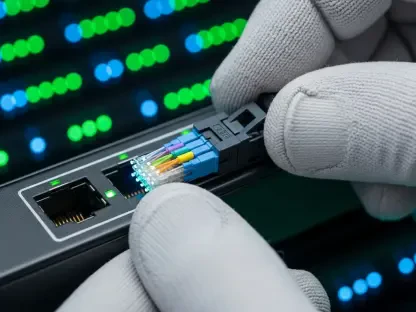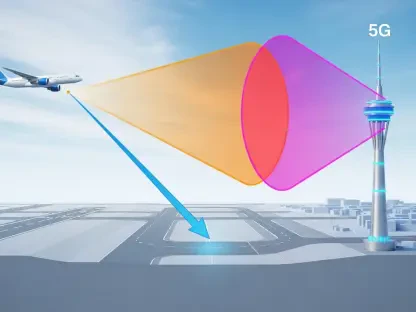The world of wireless connectivity is on the cusp of a transformative era as the 6 GHz band gains prominence in the spectrum of technological advancement. Initiated by the U.S. Federal Communications Commission (FCC) in April 2020, the release of this band for unlicensed use marked the beginning of a new chapter in wireless technology. Five years have elapsed since this significant decision, and the 6 GHz band has proven instrumental in enhancing the landscape of wireless communications. This article examines how unlicensed access to this expansive spectrum is sculpting the future of connectivity, the pivotal role it plays in the adoption of new technologies, and its impact across different geographical locations on a global scale.
Evolution of the 6 GHz Band
Regulatory Frameworks and Milestones
The emergence of the 6 GHz band as a vital asset in wireless connectivity has been grounded in strategic regulatory decisions and technological advancements. The FCC’s Notice of Proposed Rulemaking in 2018 laid the groundwork for opening up this band, culminating in the formal Report and Order in 2020. This directive was specifically tailored to facilitate low-power indoor (LPI) uses and, more prominently, Wi-Fi applications, catalyzing a new era for internet connectivity. Accelerated integration began shortly thereafter, with an increasing array of devices supporting the 6 GHz spectrum by the end of 2020.
The regulatory foresight demonstrated by the FCC in unblocking this band has not only stimulated domestic technological development but also set a precedent for international regulatory frameworks. Consequently, within a span of five years, a significant portion of the world has seen a shift in how spectrum resources are perceived and allocated. Nations such as Canada, Saudi Arabia, South Korea, and Brazil embraced the full potential of this release, following the U.S. in making the entire 6 GHz range available for unlicensed use. On the flip side, regions like Europe and Australia approached the spectrum with more caution, adopting a staged release process, which initially focuses on the lower part of the band.
Adoption Patterns and Device Integration
Device adoption timelines have rapidly evolved, reflecting the necessity of unlicensed access to the 6 GHz band. Since devices began utilizing this spectrum in 2020, the market penetration has been swift, initially targeting high-end consumer markets and quickly expanding across residential, enterprise, and public spaces. Importantly, this band has become pivotal in supporting the next-generation Wi-Fi standards, particularly Wi-Fi 6E and Wi-Fi 7, both of which demand broader channels for operation.
A significant leap in adoption has occurred over the past few years, as wide-ranging devices, from smartphones to augmented reality (AR) and virtual reality (VR) headsets, are now equipped to exploit the benefits of the 6 GHz band. Projections suggest that by this year, about a billion devices globally will operate on this spectrum, underscoring the rapid pace of integration. Furthermore, expectations are high that nearly every mid-tier to high-end device released in the U.S. will carry this capability by 2027, spotlighting the 6 GHz band as a staple in next-generation technical advancements.
Significance and Challenges of the 6 GHz Band
Technological Impact and Innovations
The significance of the 6 GHz band lies in its potential to support a multitude of technological innovations, driven significantly by the advancements in Wi-Fi standards. The advent of Wi-Fi 6E heralded early uses of the 6 GHz band, integrating it with Wi-Fi 6, yet the functional aspirations profoundly expanded with Wi-Fi 7. While Wi-Fi 6E introduced the spectrum’s potential, Wi-Fi 7 was engineered to maximize its capabilities, offering faster, more reliable connections with expanded channel widths—up to 320 MHz. This upgrade is fundamental for environments demanding high-throughput and low-latency, benefiting sectors requiring robust network performance, such as manufacturing automation and high-quality video streaming services.
Moreover, an essential element of Wi-Fi 7’s design is its ability to function optimally in dense device environments, significantly enhancing performance in scenarios involving multiple devices, like AR/VR applications and advanced robotic systems. By facilitating wide channels and precise position sensing, this innovation augments capabilities in industries where real-time data processing and interaction are crucial. This technological evolution reflects a broader industry shift towards smarter and more efficient network infrastructures, optimizing how businesses and consumers engage with digital ecosystems.
Addressing Global Implementation and Concerns
Despite its promising prospects, the 6 GHz band faces implementation challenges tied to global regulatory disparities and technical hurdles. While many countries have embraced unlicensed access, different regions are proceeding at varied paces, adapting to local spectrum needs and policy environments. Notably, countries such as China focused on licensing for cellular use; however, practical application remains dormant. This divergent approach underscores a global debate on optimizing spectrum allocation, balancing between public and commercial interests.
Technical challenges also prevail, particularly concerning interference mitigation. Adequately managing coexisting legacy systems, like fixed microwave links, requires advanced technological solutions such as Automatic Frequency Coordination (AFC) systems. These systems are engineered to dynamically navigate spectrum availability, ensuring minimal disturbance to existing operations. Progressions in Bluetooth Low Energy technology utilizing the 6 GHz band showcase its versatility and potential for low-power applications such as wearables and IoT devices, indicating a broader use spectrum outside primary Wi-Fi applications.
Future Prospects and Innovations
Beyond Traditional Use Cases
The advancements within the 6 GHz band, primarily through next-generation Wi-Fi technologies, are only a part of a larger landscape of potential applications. As the pressure on network infrastructures elevates with increased demand for high-speed connectivity, the capabilities of the 6 GHz spectrum open pathways to transcending conventional limits through new and innovative uses. Emerging applications are not just confined to faster internet for consumers—industries such as healthcare, where real-time data transfer and remote operations are critical, stand to benefit enormously.
These high-capacity networks can facilitate precision operations like remote surgery, enhanced virtual consultations, and real-time data analytics, achieving levels of efficiency and accuracy previously unattainable. In automotive sectors, enhancing vehicular communications systems within smart cities can leverage the 6 GHz band, enabling seamless integration of autonomous vehicles through faster data and communication systems. This development can precipitate a smarter infrastructure where information is shared rapidly and reliably, paving the way for outputs that could reconfigure urban living.
Strategic Collaborations and Research Directions
In realizing the full potential of the 6 GHz band, strategic collaborations across sectors emerge as crucial components. The convergence of research entities with corporate and governmental bodies can accelerate innovation and application discoveries, tailoring technical developments sufficiently to meet diverse real-world needs. These collaborations can redirect resources toward exploring less trodden paths within the band spectrum, thereby identifying prospects that harness the idle capacity for societal benefit.
The cooperative approach can help align international norms, aiding in formulating global standards that minimize fragmentation and ensure cohesive implementation practices. Investing heavily in research and development programs across public and private domains could lead to tailored solutions that amplify the reliability and efficiency of network systems worldwide. As these collaborations deepen, there is an opportunity to redefine wireless connectivity paradigms, making the 6 GHz band an even more integral part of future digital ecosystems.
Conclusion: Progression and Application of 6 GHz Technologies
The realm of wireless connectivity is entering an exciting phase with the increasing importance of the 6 GHz band in technological innovation. In April 2020, the U.S. Federal Communications Commission (FCC) paved the way for a groundbreaking shift by opening this band for unlicensed use. Over the five years since this landmark decision, the 6 GHz band has significantly enhanced the framework of wireless communications. This article delves into how unlicensed access to this broad spectrum is shaping the future of wireless connectivity and the crucial role it plays in adopting cutting-edge technologies. Having a profound influence on global connectivity, this spectrum allocation is pivotal for supporting the diverse needs of various devices, from smartphones to smart home systems, contributing to advancements in data transmission speeds and network efficiency. It also equips industries and enterprises with more robust, adaptable networks, essential for fostering innovative applications across various fields. As these wireless technologies continue to evolve, the impact of the 6 GHz band is felt across different geographical areas, offering new opportunities for growth and connectivity on a global scale.









